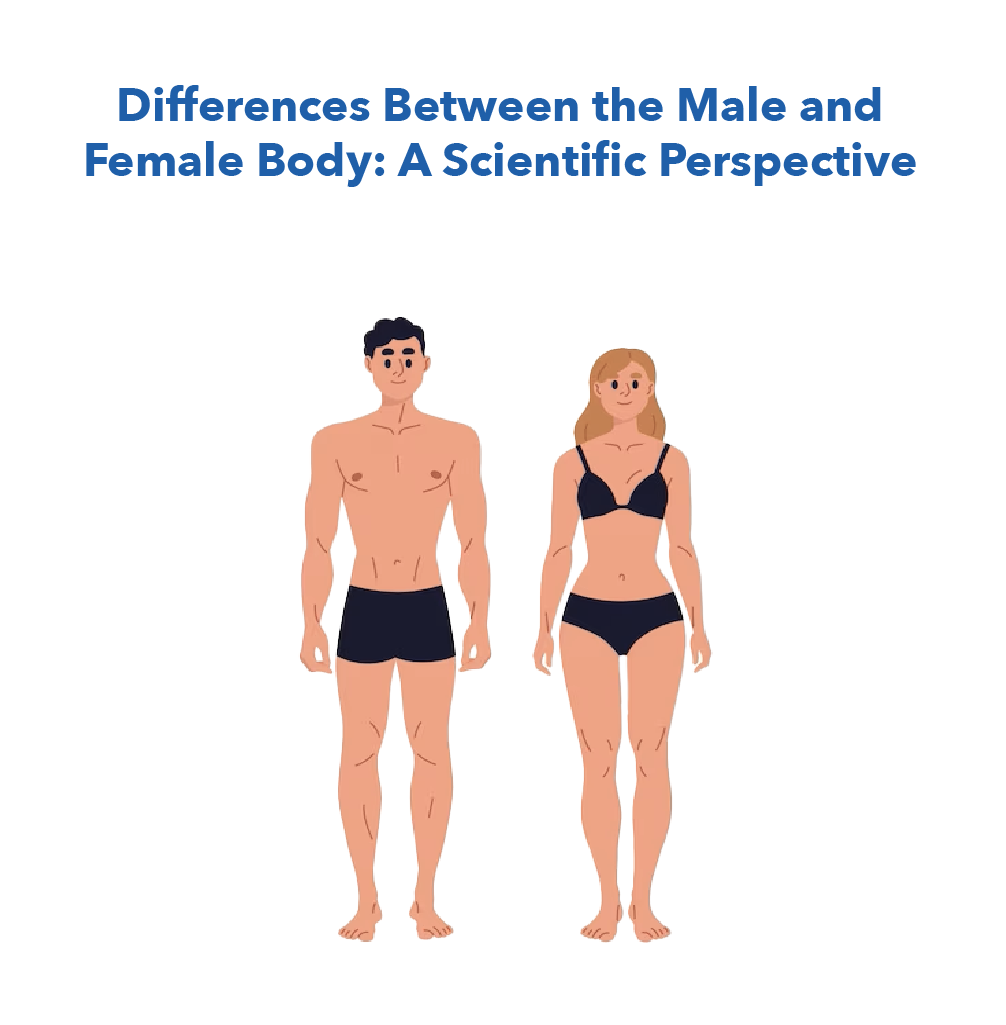Discover Related Products
Now explore supplements designed to support Longevity, Gut Health & Cellular Vitality.
CITOZYM - Support Natural Detox, Immune and Longevity Support
Differences Between the Male and Female Body: A Scientific Perspective

Understanding the differences between the male and female body is crucial not only in the medical field but also in various other disciplines such as psychology, physical education, and nutrition. This article explores the biological and physiological differences between the sexes.
Bone and Muscle Structure
One of the most evident differences between the male and female body is the bone and muscle structure. Men tend to have larger bones and more muscle mass compared to women. This is partly due to higher levels of testosterone in men, which stimulates muscle growth and bone density. Muscle growth in men is further facilitated by a higher concentration of type II muscle fibers, responsible for fast and powerful contractions.
Women, on the other hand, have a higher amount of body fat compared to men, which is distributed differently across the body. Areas such as the hips and thighs tend to be more prominent in women due to the effects of estrogen, which influences fat distribution. Additionally, women have lower bone density than men, making them more susceptible to conditions like osteoporosis, especially after menopause. The distribution of body fat in women is also influenced by leptin, a hormone produced by adipose tissue that regulates appetite and metabolism.
Reproductive System
The most obvious and significant difference between male and female bodies lies in the reproductive system. Men have reproductive organs such as testes, which produce sperm and male hormones like testosterone. Women have a reproductive system that includes ovaries, a uterus, and fallopian tubes, responsible for producing eggs and female hormones such as estrogen and progesterone.
The female menstrual cycle is a unique and complex aspect of the reproductive system, regulated by a delicate balance of hormones. This cycle affects not only reproductive capability but also various aspects of overall health in women, such as bone density and metabolism. During pregnancy, hormonal and physical changes in women are even more pronounced, with increased levels of hormones like hCG (human chorionic gonadotropin), progesterone, and estrogen, which support fetal growth and development.
Hormonal Differences
Hormones play a crucial role in the differences between male and female bodies. Men produce higher amounts of testosterone, which affects muscle mass, bone density, and behaviors typically associated with masculinity, such as aggression and competitiveness. Testosterone is also responsible for the development of male secondary sexual characteristics, such as beard growth, voice deepening, and muscle development.
Women, on the other hand, produce more estrogen and progesterone, hormones that regulate the menstrual cycle and influence various aspects of female health, such as bone density and fat distribution. Estrogens have a protective role against certain cardiovascular diseases until menopause. After menopause, the decrease in estrogen levels can increase the risk of cardiovascular diseases in women. Estrogens also influence mood and may play a role in modulating stress responses and preventing depression.
Metabolism
Another significant difference between men and women concerns metabolism. Men tend to have a higher basal metabolic rate (BMR) compared to women, meaning they burn calories more quickly. This is partly due to the greater muscle mass in men, which requires more energy to maintain. Most of the muscle mass in men is composed of type II muscle fibers, which are metabolically more active than type I fibers, predominantly present in women.
Women generally have a lower BMR and tend to store more body fat, which can be an evolutionary advantage for energy conservation. However, these metabolic differences can influence how men and women respond to diet and exercise, requiring personalized approaches for weight management and metabolic health. For example, women tend to use fats as the primary energy source during low-intensity exercise, while men tend to use more carbohydrates.
Cardiovascular System
The cardiovascular system also shows some differences between the sexes. Men tend to have larger hearts and lungs, allowing for greater oxygen transport capacity and increased physical endurance. Women, on the other hand, are generally more resistant to fatigue and can recover more quickly after physical exertion, thanks to a cardiovascular system that is more efficient in terms of blood distribution during exercise.
Additionally, women have greater arterial elasticity, which can contribute to lower blood pressure compared to men. However, this elasticity decreases with age and after menopause, increasing the risk of hypertension and other cardiovascular diseases. Estrogens play a protective role in women by improving endothelial function and reducing vascular inflammation.
Cognitive and Psychological Differences
Differences between the sexes are not limited to physical aspects but also extend to cognitive and psychological ones. Neuroscientific studies have shown variations in brain structure and function between men and women. For example, women tend to have greater connectivity between brain hemispheres, which may contribute to enhanced multitasking and communication abilities. Men, on the other hand, show stronger connectivity within hemispheres, associated with better spatial orientation and motor coordination.
Differences in levels of sex hormones also influence the brain. Estrogens, for instance, have neuroprotective effects and can enhance cognitive functions in women. Testosterone in men is associated with dominance and aggressive behaviors, as well as a greater propensity for risk-taking.
Immune System
Sex differences also extend to the immune system. Women tend to have a stronger immune response compared to men, making them more resistant to infections and diseases but also more susceptible to autoimmune diseases. Estrogens enhance the immune response by increasing antibody production and immune cell activation, while testosterone has immunosuppressive effects.
Pain Sensitivity
Studies have shown that there are differences in pain perception and tolerance between men and women. Women tend to have a lower pain threshold and higher pain sensitivity compared to men. These differences are influenced by sex hormones, which modulate pain pathways in the central nervous system. Additionally, pain experiences can be influenced by psychological and social factors, which differ between sexes.
Conclusion
The differences between the male and female body are numerous and complex, influenced by genetic, hormonal, and environmental factors. Understanding these differences is essential for various fields, from medicine to sports, and can help customize care and interventions to improve the health and well-being of both sexes.
References
- Berg, J. M., Tymoczko, J. L., & Stryer, L. (2015). Biochemistry (8th ed.). W. H. Freeman.
- DiMauro, S., & Schon, E. A. (2003). Mitochondrial Respiratory-Chain Diseases. New England Journal of Medicine, 348(26), 2656-2668.
- Kandel, E. R., Schwartz, J. H., & Jessell, T. M. (2013). Principles of Neural Science (5th ed.). McGraw-Hill.
- McNamara, J. O. (1994). Cellular and molecular basis of epilepsy. Journal of Neuroscience, 14(6), 3413-3425.
- Halliwell, B., & Gutteridge, J. M. C. (2015). Free Radicals in Biology and Medicine (5th ed.). Oxford University Press.
- Frei, B., & Trabe, M. G. (2001). The new US Dietary Reference Intakes for vitamins C and E. Redox Report, 6(1), 5-9.
- Lord, C. J., & Ashworth, A. (2012). The DNA damage response and cancer therapy. Nature, 481(7381), 287-294.







No comments